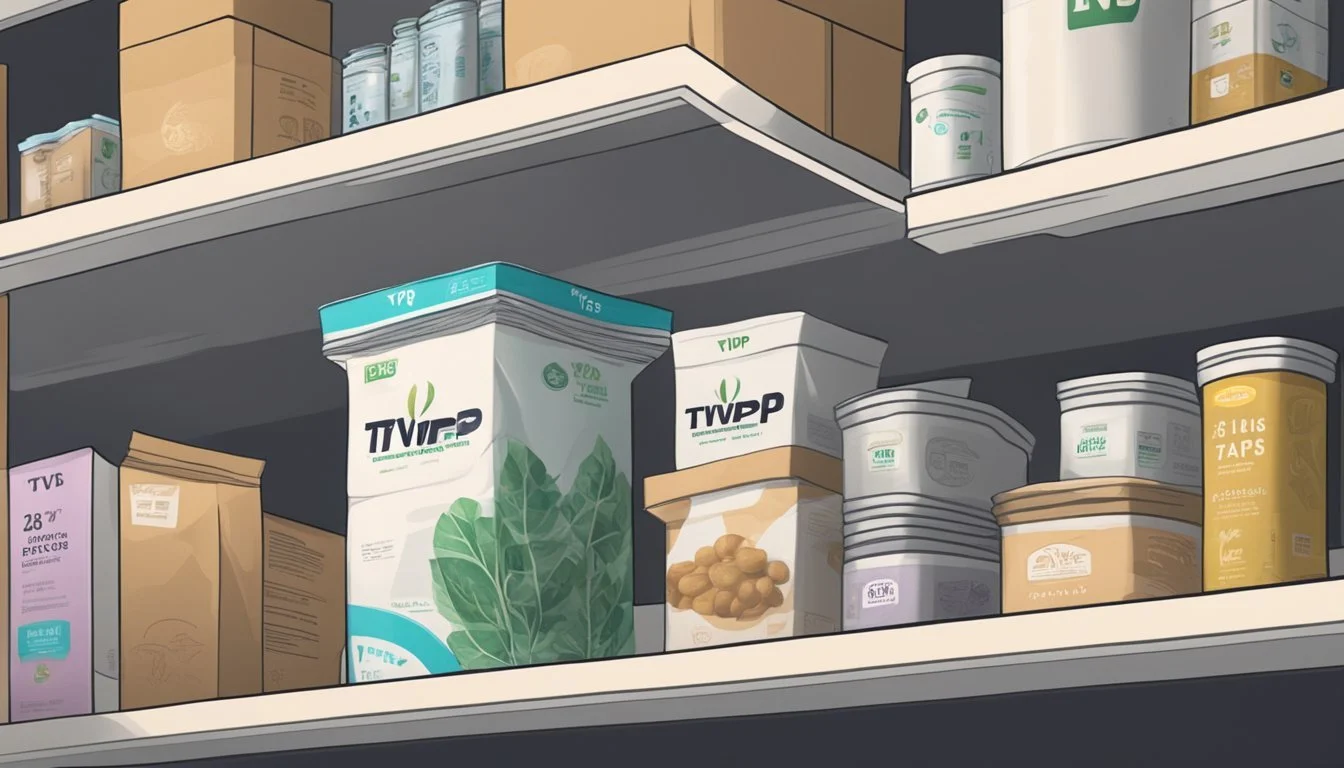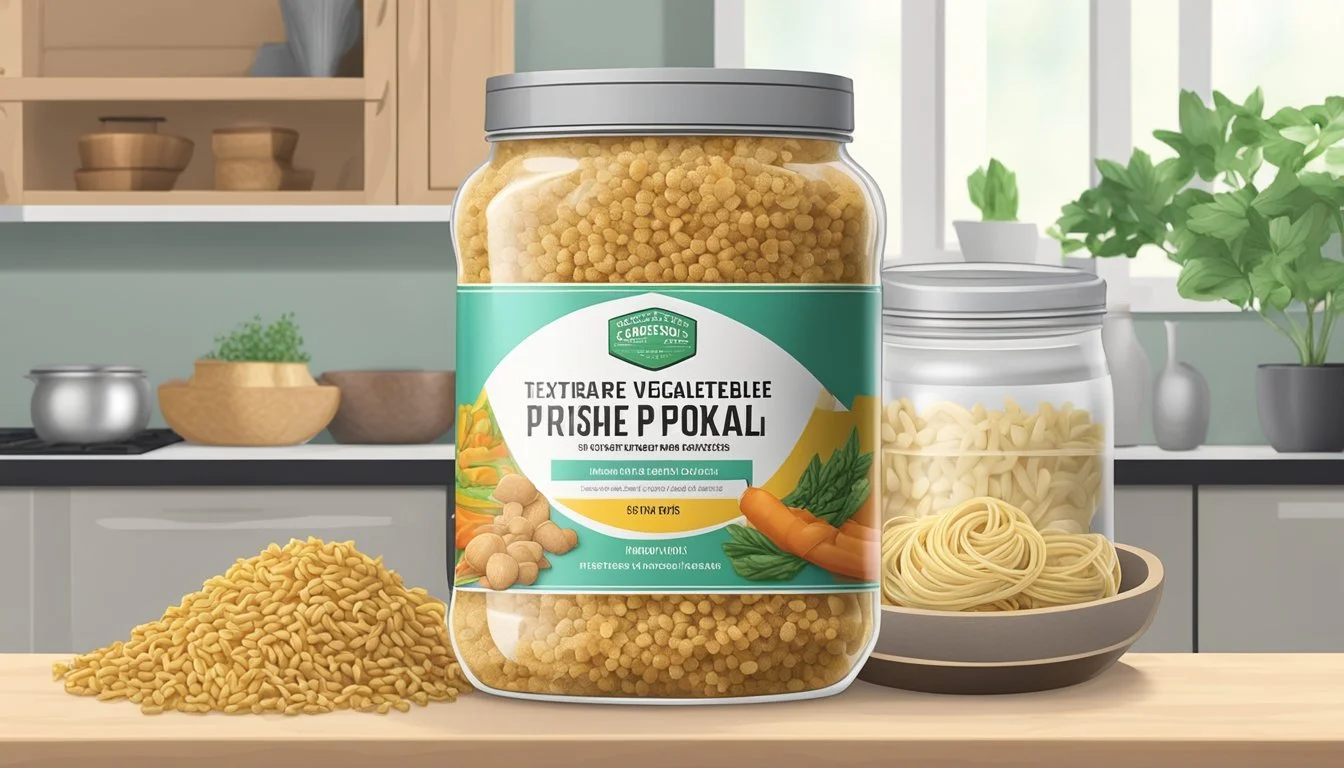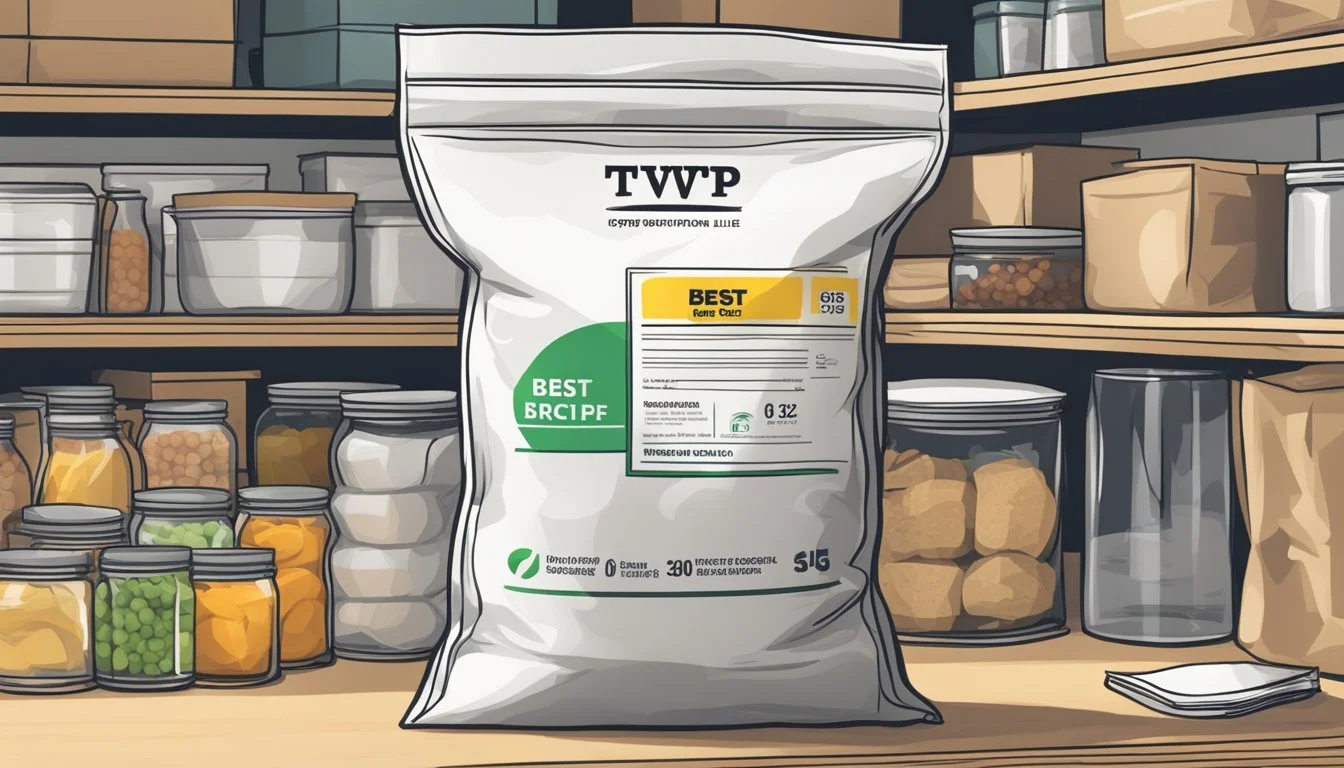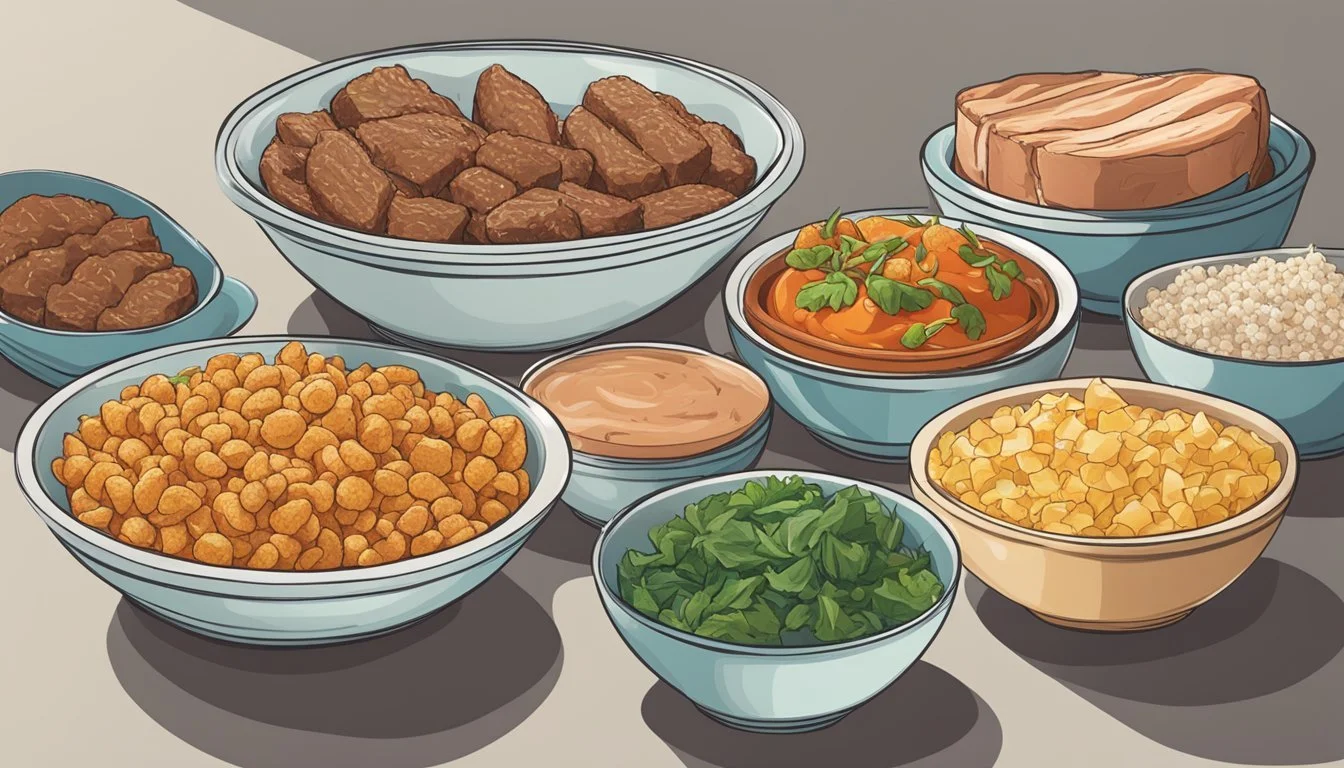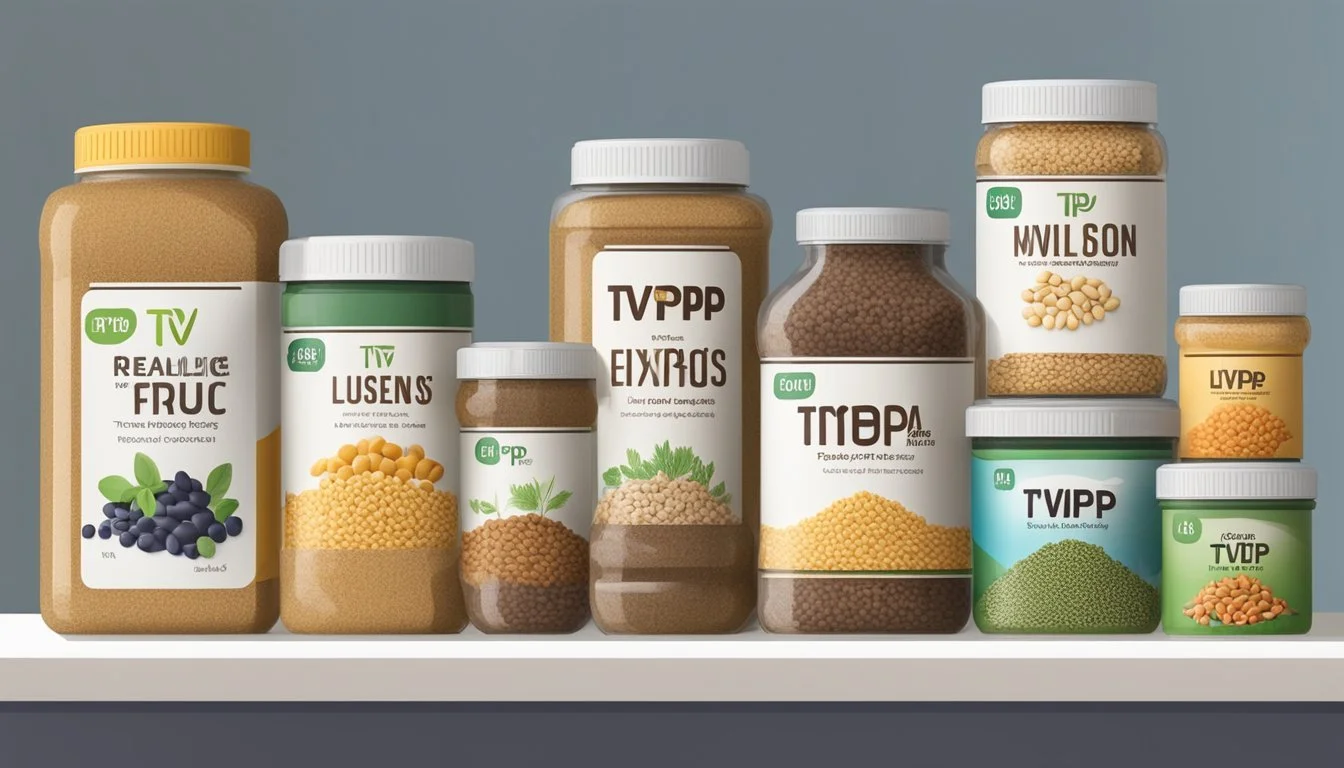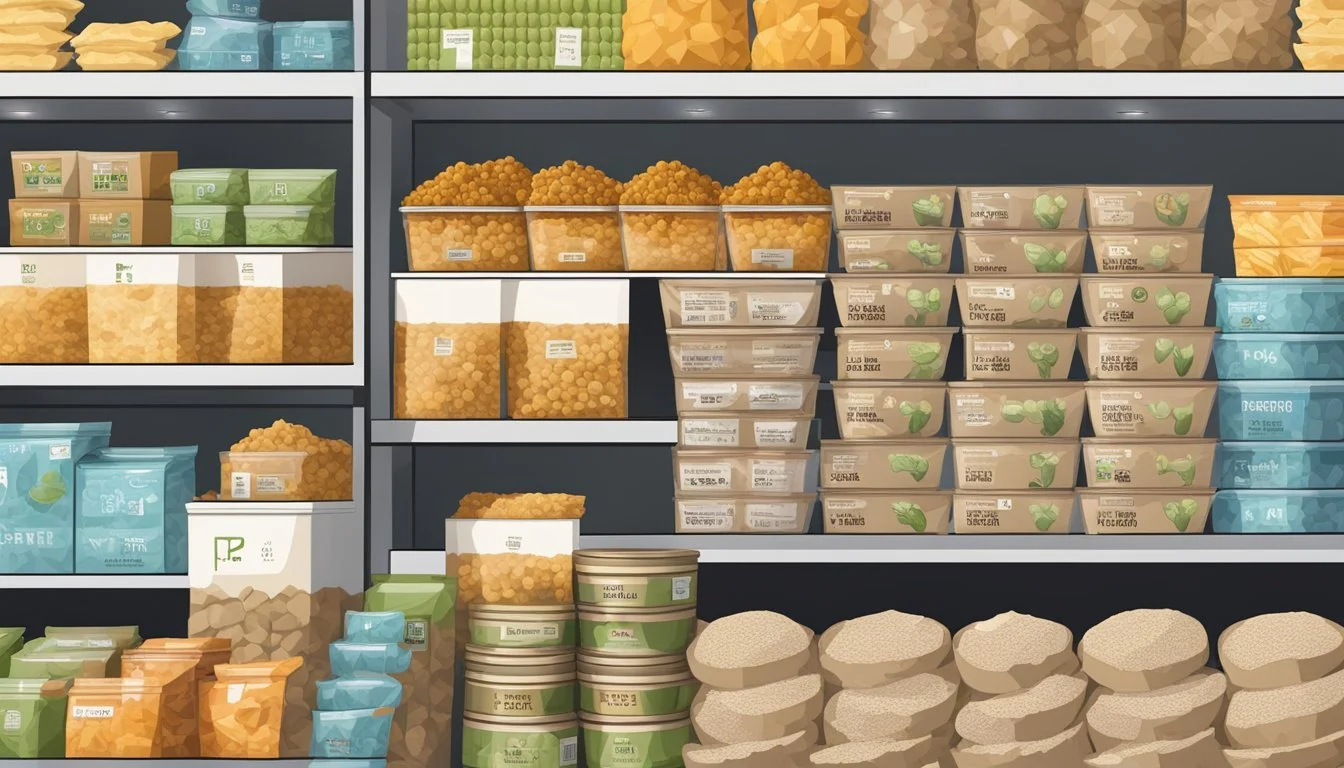How Long Does Textured Vegetable Protein (TVP) Last?
Shelf Life and Storage Tips
Textured Vegetable Protein, commonly known as TVP, is a highly nutritious soy product known for its versatility and long shelf life that makes it a staple in many pantries, particularly those seeking plant-based protein sources. Made from defatted soy flour, TVP is an economical meat substitute that can be stored for an extended period due to its dehydrated nature which inhibits the growth of microorganisms responsible for food spoilage. It typically needs rehydration before use, which is a simple process of adding boiling water or broth.
The shelf life of TVP is one of its most significant advantages, allowing consumers to keep it on hand without the worry of rapid spoilage. Due to its low-fat content and lack of moisture, Textured Vegetable Protein can last much longer than many other proteins, particularly those from animal sources. This shelf stability not only reduces food waste but also provides an accessible protein option for emergency food supplies or for those with limited access to fresh food.
While the exact duration of TVP's shelf life can vary, a general consensus is that if stored properly in a cool, dry place away from direct sunlight, it can last for an extended period, often several months to years. Proper storage involves airtight containers that prevent the ingress of moisture and pests, thereby preserving its quality and nutritional value. Assessing shelf life also requires consideration of sensory changes such as texture, aroma, and flavor, which can indicate the product's freshness and suitability for consumption.
What Is Textured Vegetable Protein?
Textured Vegetable Protein (TVP) is a highly nutritious soy product known for its versatility and meat-like texture. It is a popular choice among vegans and vegetarians for its protein content and adaptability in various dishes.
Composition and Production: TVP is made primarily from soy flour after the oil has been extracted. The process involves cooking the flour under high pressure and temperature, a method known as extrusion cooking. This results in a fibrous, spongy matrix that can be shaped and flavored to mimic meat.
Nutritional Profile: TVP boasts a notable protein content, offering a substantial amount per serving, making it an excellent plant-based protein source. Along with proteins, it is enriched with dietary fiber, aiding in digestive health.
Characteristics:
Vegan: It is entirely plant-based, derived from soybeans.
Protein-Rich: Contains a significant amount of protein.
Fiber Content: Includes dietary fiber.
Being dry and dehydrated, TVP has an extended shelf life and is conveniently shelf-stable, which means it can last a long time without refrigerating, as long as it's kept in a cool, dry place. Due to its dehydrated nature, it requires rehydration before consumption. TVP can be easily reconstituted with water or broth, expanding its volume and becoming similar in texture to ground meat. This property makes it a sustainable and economical option for a wide range of diets.
Nutritional Profile of TVP
Textured Vegetable Protein (TVP) is a processed food product derived from soybeans. It stands out as a rich source of plant-based protein, making it a popular choice among vegetarians and vegans. The protein content in TVP is significant, often containing around 15 grams of protein per 100 calories, which is higher than many other plant-based sources.
In addition to its considerable protein contribution, TVP is notable for its fiber content. A single serving provides roughly 3 grams of fiber, which aids in digestion and helps regulate blood sugar levels, labeling it as a high-fiber food item.
TVP contains essential amino acids, required for various bodily functions, due to its soybean origin. The presence of these amino acids makes it a complete protein, beneficial for muscle repair and growth.
Nutritional Minerals:
Magnesium: TVP offers a good amount of magnesium, with about 18% of the recommended daily intake in just a ¼ cup serving. Magnesium is crucial for muscle and nerve functions, as well as maintaining a healthy immune system.
Phosphorus: This mineral works in concert with calcium to promote healthy bone density. TVP is a respectable source of phosphorus.
Iron: Critical for oxygen transport in the blood, iron is found in decent amounts in TVP, aiding in preventing iron deficiency anemia, especially important for those on a plant-based diet.
The soybean derivative makes for a nutritionally dense food, suitable for various diets and lifestyles. Its versatility in recipes and the fact that it comes dehydrated for a long shelf life adds to its appeal within the health-conscious community.
Culinary Uses of TVP
Textured Vegetable Protein (TVP) serves as a versatile ingredient in many dishes due to its ability to absorb flavors and emulate the texture of meat. In cookery, its primary applications involve rehydration before use and its role as a meat substitute in vegan and vegetarian meals.
Rehydrating TVP for Recipes
To prepare TVP for inclusion in recipes, one must first rehydrate it. This process involves adding a liquid, such as water or broth, to dry TVP. The standard ratio is 1.5 parts TVP to 1 part boiling liquid. After combining the two, it is important to let the mixture sit for about 10 minutes to allow the TVP to absorb the liquid fully and expand. After rehydrating, TVP can be incorporated into a variety of dishes, such as chili, tacos, and lasagna, adding texture and protein.
TVP in Vegan and Vegetarian Cooking
In vegan and vegetarian cooking, TVP stands out as a significant meat substitute. Chefs often use it as a plant-based alternative to ground meat due to its similar texture when cooked. TVP is commonly featured in recipes that traditionally use meat, offering a satisfying substitute without compromising on protein content or mouthfeel. It seamlessly integrates into dishes like burgers, meatballs, or vegetative crumbles for tacos. Due to its neutral taste, it readily takes on the spices and seasonings of any recipe it's added to, making it an excellent ingredient for cooks to have in their pantry.
Storage and Shelf Life
When considering the longevity of textured vegetable protein (TVP), it's paramount to focus on two main factors: storage conditions and the type of TVP. Generally, TVP's shelf life can be quite extensive if stored properly.
Unflavored TVP, preserved dry in an airtight container, is robust in longevity. Often, it can last indefinitely when kept away from moisture and heat. This is due to its dehydrated nature, which inhibits bacterial growth and mold.
For flavored types of TVP, their shelf life typically spans up to one year. Like unflavored TVP, these should also be stored in a sealed container in a pantry.
Optimal storage conditions include:
Temperature: A cool environment is ideal.
Moisture: A dry place is critical for storage.
Moreover, when stored with oxygen absorbers, TVP's shelf life may be further extended by minimizing oxidation.
After hydration, TVP's shelf life shortens considerably. It should then be treated as a perishable. Once hydrated, TVP should be stored in the refrigerator and ideally consumed within three to four days. For longer-term storage, one can freeze prepared TVP, extending usability.
To summarize, it is essential for consumers to store TVP in a manner that limits exposure to heat, moisture, and oxygen to ensure its longevity while maintaining its quality.
Factors Affecting TVP Longevity
The shelf life of Textured Vegetable Protein (TVP) can be significantly influenced by certain factors. Understanding these can help maximize its longevity.
Impact of Storage Conditions on TVP
Temperature: Keeping TVP in a cool, dry environment helps preserve its quality. Exposure to high temperatures can lead to degradation and a shorter shelf life.
Sealed Packaging: Upon purchasing, TVP typically comes in sealed packages. Once opened, transferring it to an airtight container prevents moisture and air from affecting its quality.
List of recommended storage conditions for TVP:
Temperature: Keep below 75°F (24°C).
Humidity: Store in a low-humidity area.
Container: Use an airtight container after opening original packaging.
Location: Store in a dark pantry or cupboard away from direct sunlight.
Signs of Spoilage in TVP
One can assess TVP's quality through sensory evaluation:
Appearance: Discoloration or the presence of mold indicates spoilage.
Smell: An off smell or any unfamiliar odors may suggest that the TVP is no longer suitable for consumption.
Texture: Although TVP is dehydrated, if it takes on a notably hard or exceptionally tough texture, this could be a result of improper storage conditions or spoilage.
When rehydrated, spoiled TVP may exhibit:
Unpleasant taste: Any strong, off-putting flavors are signs that the TVP should not be consumed.
Unexpected texture changes: If the rehydrated TVP has an abnormal texture, this may indicate spoilage.
Health Considerations of TVP
Nutritional Profile: Textured vegetable protein (TVP) is often chosen for its high-protein content and low-cholesterol benefits. A single serving provides essential amino acids and can serve as an alternative to meat for vegetarians and vegans. Being made from defatted soy flour, it lacks the fats associated with animal proteins, positioning it as a heart-friendly ingredient in diets.
Dietary Fiber: As an added advantage, TVP's high dietary fiber content aids digestion and can contribute to better gut health. The fiber in TVP helps slow the absorption of sugar in the bloodstream, thereby assisting in managing blood sugar levels.
Genetic Modification: Consumers should be aware that TVP is often made from soybeans, which may be genetically modified. Those who prefer to avoid genetically modified organisms (GMOs) might wish to seek out non-GMO certified products.
Risk Factors: Individuals with soy allergies or sensitivities could experience adverse reactions due to its soybean origin. It is also important for people to introduce TVP into their diets gradually because a sudden increase in fiber can cause digestive discomfort.
Health Benefits: Due to its composition, TVP can play a role in reducing the risk factors associated with heart disease. Its usage as a meat substitute could also aid in overall calorie reduction, contributing to better weight management when paired with a balanced diet.
When considering TVP in one’s diet, assessing both its nutritional benefits and potential concerns is essential. Consumers should balance the high protein content and cholesterol-lowering benefits with personal dietary needs and potential allergen sensitivity.
Comparing TVP to Other Meat Substitutes
Textured Vegetable Protein (TVP) is a versatile meat substitute offering high protein content and favorable storage qualities. It competes with other plant-based options like tofu and tempeh in nutrition, texture, and culinary flexibility.
TVP Versus Tofu
Tofu, originating from soybeans, presents a softer texture and is less dense in protein compared to TVP. While tofu contains approximately 10 grams of protein per 100 calories, TVP boasts about 15 grams of protein per same caloric value. Tofu offers a smooth, creamy texture which is useful in a variety of dishes ranging from smoothies to stir-fries. In contrast, TVP's texture is more similar to that of ground meat, making it ideal for recipes requiring a firmer texture, such as soy burgers or vegan "meat" crumbles.
Protein Content Comparison:
Tofu: ~10g protein/100 calories
TVP: ~15g protein/100 calories
TVP Versus Tempeh
Tempeh, another soy-based meat substitute, is known for its firm texture and nutty flavor. It is a whole soybean product with a higher fiber content and possesses a different nutritional profile when compared to TVP. TVP, being defatted soy flour, lacks some of the micronutrients present in tempeh but excels in protein efficiency. Due to its concentrated form, TVP can easily absorb flavors and seasonings, which is especially beneficial in creating meat-like dishes such as vegan meat sausages or taco fillings.
Texture & Nutrition: Quick Facts:
Tempeh: Firm, nutty, higher in fiber
TVP: High protein efficiency, flavor-absorbent
By examining protein content and cooking applications, consumers can make informed decisions when choosing between TVP and other meat substitutes like tofu and tempeh.
Preparing and Cooking With TVP
Before cooking with Textured Vegetable Protein (TVP), one must understand that hydration is essential, as TVP is often sold in dehydrated form. To ensure the best texture and flavor, proper rehydration and seasoning techniques are applied, making TVP an excellent base for many plant-based dishes.
Hydration Techniques for TVP
To rehydrate TVP, the cook must combine it with a liquid, typically water or vegetable broth, in a specific ratio. For a standard method:
Measure the desired amount of dry TVP.
Pour boiling water or broth over it at a ratio of 1.5:1 (TVP to liquid).
Let it sit for about 10 minutes or until it becomes plump and tender.
Alternative methods include microwaving TVP covered with liquid for 5-6 minutes, checking halfway to add more liquid as necessary.
Incorporating Spices and Flavors into TVP
After hydration, TVP tends to be quite bland and benefits significantly from robust seasoning. One may introduce flavors using:
Salt and pepper, mixed to taste.
Soy sauce and ketchup for a umami depth and a hint of sweetness.
Other spices such as garlic powder, onion powder, or smoked paprika.
The cook may also sauté TVP in a small amount of oil to infuse it with aromatics and spices before adding it to recipes.
TVP as a Filling for Plant-Based Dishes
Once prepared, TVP can be an excellent filling for a variety of dishes. It's a versatile ingredient that can mimic ground meat:
Mix hydrated TVP with spices and bind together with flour or an egg to form veggie burgers.
Use it as a filling for tacos, burritos, or even stuff it into vegetables.
Incorporate it into pasta sauces, casseroles, or use as a protein-rich topping for nachos.
Its granulated or flaked texture allows TVP to integrate into dishes seamlessly, making it a go-to for adding plant-based protein to any meal.
TVP's Role in Vegan and Vegetarian Diets
Textured Vegetable Protein (TVP) is a versatile soy product known for its utility in vegan and vegetarian nutrition. As a high-protein, plant-based substitute, TVP offers an alternative to meat, eggs, and other animal products. It is derived from soy flour with the oil removed, which concentrates the protein content, making it an excellent choice for those seeking to increase their protein intake.
Nutritional Profile: TVP notably contains a substantial amount of protein, which is vital for muscle repair and growth. Its inclusion in vegan and vegetarian diets helps fulfill the daily protein requirements that may otherwise be challenging to meet with plant-based sources alone.
Usage in Cooking: Because TVP is essentially flavorless, it readily absorbs the flavors of the dishes it's cooked with. This characteristic enables it to mimic the textures and flavors of meat products, which is particularly appealing in vegetarian and vegan cooking. Here is how it can be utilized:
Rehydrate with liquids: Boil in water or broth until soft.
Season as desired: Incorporate into recipes that require ground meat.
Cook: Add to sauces, stews, or use in patties.
In vegan baking, TVP can also serve as a binding agent, taking the place of eggs in some recipes. This makes it a multi-functional ingredient beyond just a meat substitute.
Shelf Stability: Another benefit is its long shelf life. Dehydrated, it remains stable for extended periods, making it a convenient staple in plant-based pantries.
In summary, TVP is a nutritionally dense, high-protein food that is integral to vegan and vegetarian diets, serving as a meat alternative and nutritional supplement. Its adaptability in recipes and long shelf life makes it a practical choice for those following plant-based lifestyles.
Choosing the Right TVP Product
When selecting textured vegetable protein (TVP), it is crucial to consider the variety and flavor to ensure that it meets one's culinary needs and taste preferences.
Types of TVP
Textured vegetable protein, made predominantly from soy protein, is available in several forms including chunks, strips, nuggets, and as a ground beef alternative. The form of TVP one chooses should align with their intended use; chunks are suitable for stews and curries, while ground forms work well in tacos and spaghetti sauces.
Chunks: Ideal for hearty meals, mimicking diced meat.
Strips/Nuggets: Excellent for stir-fries or as a protein-packed snack.
Ground: Best suited for recipes requiring a ground meat texture, such as burgers or bolognese sauces.
Unflavored TVP Versus Flavored Varieties
Unflavored TVP is versatile, allowing individuals to incorporate their own seasonings and tailor the flavor to their specific recipes. It absorbs spices and marinades well, making it an excellent canvas for culinary creativity.
Unflavored:
Pure, without added taste, adapts to any recipe.
Requires seasoning for enhancement before use.
On the other hand, flavored TVP varieties can save time and provide convenience for quick meal preparation, as they are pre-seasoned with flavors designed to mimic certain meats or cuisines.
Flavored:
Pre-seasoned, offering ease in cooking.
Available in tastes mimicking chicken, beef, or pork.
Shoppers should note that textured soy protein is another term for TVP and possesses the same attributes mentioned above.
Innovations and Market Trends in TVP
The Textured Vegetable Protein (TVP) market is undergoing significant transformation, with advancements in processing technology and a surge in consumer demand for plant-based proteins shaping its future.
Advancements in TVP Processing
Recent innovations in the processing of TVP have led to improved texture and taste, making it a more appealing meat substitute. Companies like Archer Daniels Midland have refined their production techniques to deliver a product that is not only high in protein but also in dietary fiber, catering to health-conscious consumers. Technological advancements have enabled the production of TVP that closely mimics the mouthfeel of real meat, which has been instrumental in its adoption in both homes and professional kitchens.
Growing Demand for Plant-Based Proteins
The demand for plant-based proteins is on the rise as more consumers adopt vegan and vegetarian diets for health, ethical, and environmental reasons. TVP, commonly found in grocery stores and bulk foods sections, has become a staple ingredient in vegetarian cooking. The market trends indicate a growing preference towards foods that are not only sustainable but also nutrient-dense, with TVP being a prime example due to its soybean oil content. Its high-fiber profile and versatility in recipes have established it as a key player in the plant-based food industry.
Environmental Impact of TVP Production
Textured vegetable protein (TVP) is predominantly derived from soybeans, a crop that comes with its own environmental footprint. The production of TVP tends to have a lower environmental impact than animal-based protein sources, particularly in terms of greenhouse gas emissions, land use, and water consumption. The resource efficiency of TVP production makes it a more sustainable option in comparison to meat.
However, there are concerns with the reliance on soybean cultivation. Large-scale soy farming has been linked to deforestation, especially in South America. The conversion of forest land into soy plantations significantly reduces biodiversity and increases carbon emissions.
Sustainability initiatives within the TVP industry focus on improving agricultural practices, such as crop rotation and reduced pesticide use. Moreover, the industry is exploring alternative protein sources such as wheat and peas to diversify impact and reduce dependency on soy.
A portion of the soybeans used in TVP production are genetically modified (GM). While this can increase crop yields and pest resistance, the long-term environmental impact of GM crops is a topic of ongoing debate. Opponents argue that GM crops could potentially lead to reduced genetic diversity and unforeseen ecological disruptions.
In summary, while TVP presents a more environmentally friendly alternative to meat, the industry faces challenges regarding the sustainability of soybean farming and the use of genetically modified crops. It is crucial for producers to engage in responsible sourcing and farming practices to minimize environmental footprint.
Pros of TVP Production Cons of TVP Production Lower GHG emissions Potential for deforestation Reduced land use Biodiversity loss Lower water consumption Ecological disruptions from GM crops Resource efficiency Reliance on single crop (soy)
Costs and Economic Aspects of TVP
Textured Vegetable Protein (TVP) is a cost-effective alternative to animal protein, prized for its economic advantages both for consumers and producers. Being plant-based, TVP is less resource-intensive to produce than meat, translating into lower retail prices.
Consumers will find that TVP is generally inexpensive, especially when purchased in bulk. Grocery stores often stock it in their bulk foods section, enabling savings when bought in larger quantities. Below is a comparison of TVP cost versus other protein sources:
Protein Source Cost Per Pound TVP $3 - $5 Ground Beef $5 - $7 Chicken Breast $3 - $6
The price of TVP can also vary depending on whether it's organic or non-organic, with the former being slightly more expensive. However, even organic TVP tends to be cheaper than its meat counterparts.
At a grocery store, one may find TVP located near the dry goods or with alternative meat products. Its shelf-stability means it can be stored without refrigeration, impacting store economics by reducing the need for costly chilled storage.
For households, TVP offers considerable savings. Its long shelf life minimizes waste, and since it's dehydrated, consumers are not paying for the water weight that can comprise a significant portion of fresh or frozen meat.
In summary, Textured Vegetable Protein stands out as an economically viable nutrient source. It enables consumers to stretch their food budgets without compromising on their protein intake, making it an attractive option for those looking to balance nutrition with cost.
Potential Risks and Controversies Around TVP
Textured Vegetable Protein (TVP) has been subject to various discussions regarding its safety and health implications. While TVP is a convenient source of protein, especially for vegetarians and vegans, it is also a highly processed food. During processing, a concern is the potential use of hexane—a chemical solvent used to extract oil from plants. While the FDA considers hexane residues in foods as safe, some health proponents argue for the minimization of chemical use in food processing due to potential long-term effects.
Bacterial infection is another risk associated with TVP, as with any food product if it is not stored or handled properly. Dry TVP has a long shelf life, but once rehydrated, it needs refrigeration and should be treated like other perishable foods to prevent bacterial growth.
Regarding nutritional content, TVP is often criticized for its omega-3 profile. Being made from soybeans, it contains some omega-3 fatty acids, but these may not be in an optimal ratio with omega-6 fatty acids, which can influence inflammation and overall health.
Another common concern with TVP and similar products is the production of gas or bloating, as some individuals might find they have sensitivities to soy products that can result in digestive discomfort.
Here are key points regarding the risks:
Hexane: Used in processing, raises health controversy despite FDA's position
Bacterial Infection: Proper storage post-rehydration critical to prevent spoilage
Omega-3: Suboptimal fatty acid balance can affect inflammatory response
Digestive Issues: Can cause gas and bloating in sensitive individuals
The debate over processed foods like TVP suggests a balance between the benefits of high-protein, plant-based foods and mindful consideration of processing methods and individual health responses.

